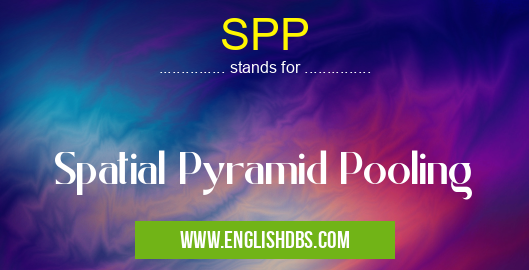What does SPP mean in UNCLASSIFIED
Spatial Pyramid Pooling (SPP) is a technique used in computer vision to extract features from images, regardless of their size. It was introduced in the seminal paper "Spatial Pyramid Pooling in Deep Convolutional Networks for Visual Recognition" by He et al. in 2014. SPP has since become a standard component in many deep learning models for image classification and object detection tasks.

SPP meaning in Unclassified in Miscellaneous
SPP mostly used in an acronym Unclassified in Category Miscellaneous that means Spatial Pyramid Pooling
Shorthand: SPP,
Full Form: Spatial Pyramid Pooling
For more information of "Spatial Pyramid Pooling", see the section below.
How SPP Works
SPP divides an image into a pyramid of sub-regions, each of which is pooled to produce a single feature vector. The pooling operation can be max-pooling, average-pooling, or any other type of pooling. The size of the sub-regions decreases as one moves up the pyramid, resulting in a hierarchical representation of the image.
The main advantage of SPP is its invariance to image size. By pooling over multiple sub-regions of different sizes, SPP can capture features at different scales and orientations, making it robust to variations in image scale and aspect ratio.
Benefits of SPP
- Invariance to image size: SPP extracts features that are independent of the input image size, making it suitable for images of varying dimensions.
- Multi-scale representation: The hierarchical structure of SPP allows it to capture features at different scales, which is essential for tasks such as object detection and scene recognition.
- Efficient computation: SPP is a relatively efficient technique, as it can be implemented using a single forward pass through a convolutional neural network (CNN).
Essential Questions and Answers on Spatial Pyramid Pooling in "MISCELLANEOUS»UNFILED"
What is SPP (Spatial Pyramid Pooling)?
SPP is a technique used in computer vision to extract features from an image. It is commonly applied in object recognition and scene classification tasks. SPP divides the image into a hierarchical pyramid structure and then performs max pooling on each level of the pyramid. This allows the model to capture features at different scales and locations within the image.
How does SPP work?
SPP divides the image into a hierarchical pyramid structure. The bottom level of the pyramid is the original image. Each subsequent level is created by dividing the previous level into smaller regions. Max pooling is then performed on each level of the pyramid. This results in a set of feature vectors that represent the image at different scales and locations.
What are the benefits of using SPP?
SPP has several benefits, including:
- It allows the model to capture features at different scales and locations within the image.
- It is computationally efficient.
- It is easy to implement.
What are the limitations of using SPP?
SPP has some limitations, including:
- It can be sensitive to the size and shape of the image.
- It can be difficult to determine the optimal number of levels in the pyramid.
How is SPP used in practice?
SPP is commonly used in object recognition and scene classification tasks. It is often used as a pre-processing step before feeding the image into a convolutional neural network (CNN).
Final Words: Spatial Pyramid Pooling is a powerful technique for extracting features from images, regardless of their size. Its invariance to image scale and its ability to capture multi-scale features make it a valuable tool in computer vision tasks. SPP is widely used in deep learning models and has contributed significantly to the advancement of image analysis and object recognition.
SPP also stands for: |
|
| All stands for SPP |
